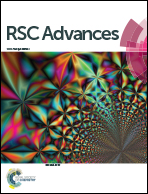Modulation of the surface properties of protein particles by a surfactant for stabilizing foams†
Abstract
In this study, a detailed investigation into the behavior of foams stabilized by mixtures of zein/TA colloidal particles (ZTP) with a conventional anion surfactant (sodium dodecyl sulfate, SDS) has been made. Foams stabilized by either particles or surfactants alone break down completely within one day at all concentrations tested in the present study. However, ZTP can be induced to form fractal clusters in the presence of a surfactant. In mixed particle–surfactant systems, a synergism occurs with respect to foam properties, since the fractal clusters can be used as building blocks with reaction activity to form stable foams with an orderly interfacial architecture. The formability of ZTP–SDS mixtures increases with the increase of SDS concentration. However, the foam stability increases to a maximum at 0.6 mM SDS followed by a decrease at higher SDS concentrations. In addition, the presence of SDS increases the surface tension decay rate and dilatational modulus, but it seems that their changes are not directly proportional to the SDS concentration. This study indicates that particle–surfactant mixtures can be a potential strategy to modify the particle surface properties and therefore improve foam properties, facilitating the application of zein-based particles in the food and cosmetic industry.


 Please wait while we load your content...
Please wait while we load your content...